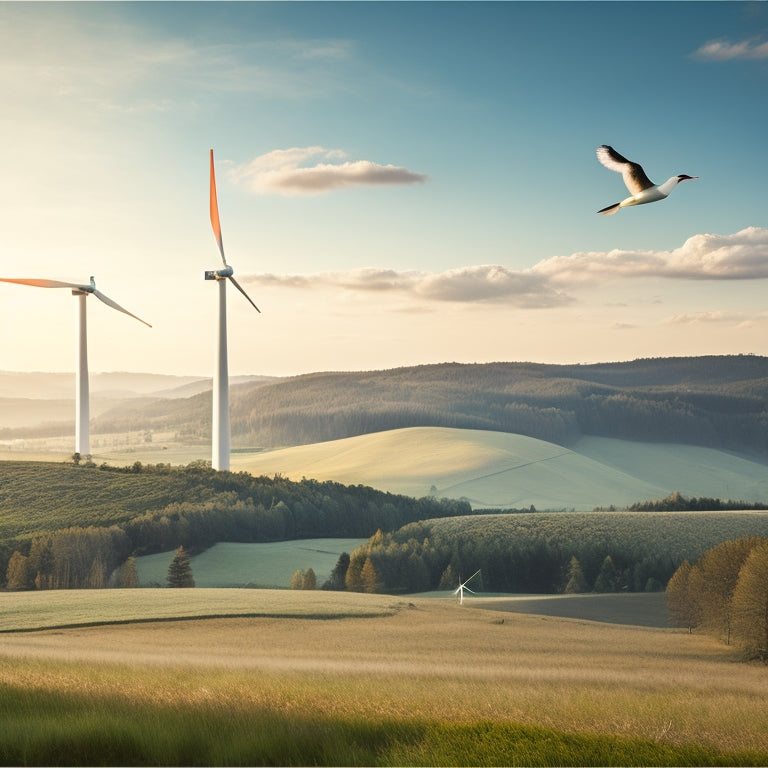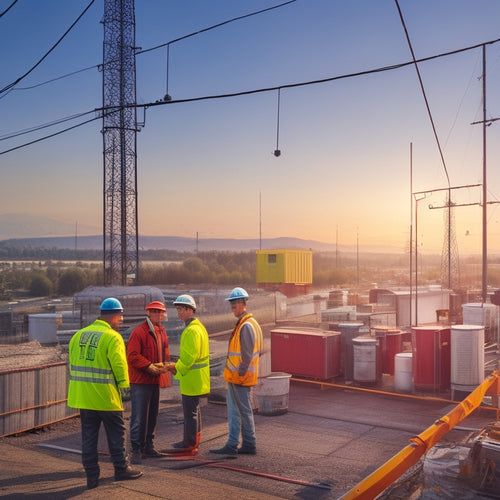
Wind Turbines' Environmental Impact on Wildlife
Share
Wind turbines do have a notable environmental impact on wildlife, particularly through habitat disruption and behavioral changes in local animal populations. They can alter migration patterns, especially for birds, increasing risks of collisions due to turbine design and placement. Operational noise from turbines may lead to stress in mammals and disturbances in bird communication. However, responsible site selection and habitat preservation strategies are essential to mitigate these effects. Ongoing monitoring helps understand these challenges better and promotes sustainable practices. If you want to investigate how these factors interconnect, there's much more to uncover.
At a Glance
- Wind turbines can disrupt local wildlife behavior through noise pollution, affecting communication and potentially altering migration patterns.
- Bird collision risks are mitigated through innovative turbine designs and ongoing monitoring to reduce avian population impacts.
- Habitat preservation and restoration efforts are crucial to minimize ecological impacts and enhance biodiversity around wind farm installations.
- Wind energy significantly reduces carbon emissions, contributing to cleaner air and supporting efforts against climate change.
- Continuous research and community involvement are essential for effective conservation strategies that balance energy needs with wildlife protection.
Wildlife-Friendly Energy Solution
When considering wildlife-friendly energy solutions, it's essential to implement habitat preservation strategies that protect local ecosystems.
Utilizing innovative designs, such as solar windows, can further enhance energy independence while minimizing environmental disruption.
Additionally, minimizing bird collisions with wind turbines can greatly reduce the negative impact on avian populations.
Habitat Preservation Strategies
Wind turbines, towering structures designed to capture renewable energy, can pose threats to local wildlife if not carefully integrated into their habitats. To mitigate these risks, effective habitat preservation strategies are vital. You can actively support conservation initiatives that prioritize ecosystem health and biodiversity.
One approach is habitat restoration, which involves rehabilitating areas affected by turbine installations. By reestablishing native vegetation and promoting natural ecosystems, you help create safer environments for wildlife. This restoration can also enhance the environment's resilience against climate change, providing long-term benefits for both nature and energy production.
Moreover, you can advocate for responsible site selection for new wind farms. Choosing locations with minimal ecological impact reduces disruption to wildlife habitats. Involving local communities in the planning process guarantees that conservation priorities align with energy goals.
Supporting ongoing monitoring and research initiatives is significant, too. These efforts can assess the long-term effects of wind turbines on wildlife, enabling continuous improvement of preservation strategies.
Minimizing Bird Collisions
To protect avian populations, minimizing bird collisions with wind turbines is essential in developing wildlife-friendly energy solutions. Understanding bird behavior and their flight patterns is significant for effective collision mitigation strategies. By integrating knowledge from avian studies, developers can assess the risks associated with turbine placement, ensuring that turbines are sited away from critical migratory routes and nesting areas.
Advancements in turbine design can also play a substantial role in reducing collisions. For instance, using blades that are more visible to birds can decrease the likelihood of accidents.
Implementing radar technology enhances wildlife monitoring, allowing operators to track bird movements in real time. This data supports informed decisions regarding turbine operation, particularly during peak migratory seasons.
Moreover, ongoing risk assessment is essential for evaluating the effectiveness of these measures. By continuously refining conservation efforts based on emerging research, the wind energy sector can minimize its impact on avian populations while promoting sustainable energy.
Ultimately, a comprehensive approach that combines innovative turbine design, strategic placement, and advanced monitoring will help create a more harmonious coexistence between wind energy developments and wildlife.
Reduced Carbon Footprint
Wind turbines play an essential role in reducing greenhouse gas emissions, which is important for combating climate change. By utilizing wind energy, you're contributing to a cleaner atmosphere and promoting sustainable energy solutions.
This shift not only lessens your carbon footprint but also helps mitigate the adverse effects of climate change on wildlife and ecosystems.
Additionally, integrating renewable energy sources like wind power can lead to significant energy cost savings, particularly when combined with effective energy management strategies, thereby supporting a more sustainable business model while reducing reliance on fossil fuels energy management strategies.
Lower Greenhouse Gas Emissions
Research shows that shifting to wind energy can greatly lower greenhouse gas emissions, contributing to a reduced carbon footprint. By utilizing wind power, you can actively participate in achieving carbon offset benefits, which are vital in addressing climate change. Wind energy stands out among renewable energy advantages as it generates electricity without releasing harmful pollutants.
| Energy Source | CO2 Emissions (g/kWh) | Carbon Offset Benefits |
|---|---|---|
| Wind | 0 | Significant reduction in emissions |
| Natural Gas | 450 | Moderate reduction |
| Coal | 900 | Minimal reduction |
| Solar | 50 | Positive but less impactful |
The table above illustrates how wind energy's zero CO2 emissions per kilowatt-hour solidify its role as a key player in reducing greenhouse gases. By choosing wind power, you're not only supporting sustainable energy but also enhancing your freedom from fossil fuel dependency. This shift enables you to contribute to a cleaner environment and a healthier planet, emphasizing the deep impact of collective action in mitigating climate change.
Mitigating Climate Change Effects
A notable way to mitigate climate change effects is by reducing your carbon footprint through the adoption of renewable energy sources, particularly wind power. By utilizing wind turbines, you utilize a clean energy source that markedly lowers greenhouse gas emissions compared to fossil fuels. This shift not only helps in curbing climate change but also improves climate adaptation strategies, allowing communities to become more resilient to environmental changes.
Wind energy contributes to ecological resilience by promoting biodiversity and sustaining natural habitats. Unlike traditional energy sources, wind power generates electricity without depleting resources or emitting harmful pollutants. As you accept wind energy, you play an essential role in cultivating a healthier ecosystem, which can better withstand climate-related stressors.
Moreover, the widespread implementation of wind turbines encourages innovations in energy storage and distribution, making renewable energy more accessible to all. By prioritizing wind power, you're taking an active stance in the fight against climate change and supporting sustainable practices that benefit both the environment and society.
Ultimately, your commitment to reducing your carbon footprint through renewable energy sources can lead to a more sustainable future for generations to come.
Operational Noise Levels
Operational noise levels from wind turbines can markedly affect local wildlife, particularly birds and mammals.
Research indicates that evaluating energy needs and usage can help us understand how noise pollution may influence animal behavior.
You might find that noise can disrupt communication among birds and alter mammal behavior, influencing their feeding and mating patterns.
Understanding these impacts is essential for evaluating the overall environmental consequences of wind energy.
Noise Effects on Birds
Wind turbines generate significant operational noise that can affect bird behavior and communication. The noise pollution produced by these structures can interfere with how birds interact with each other, impacting their ability to communicate effectively.
Birds rely heavily on vocalizations for mating, territorial claims, and warning calls, so any disruption can have serious consequences for their social structures and survival.
Research indicates that as noise levels increase, birds may alter their vocalizations, either by changing pitch or increasing volume to be heard above the din. This adaptation, while necessary, can lead to increased stress and energy expenditure.
Additionally, the frequency of these sounds might mask important calls, leading to reduced mating success or inadequate predator warnings.
You might wonder about the broader implications of this noise on bird populations. Over time, continuous exposure to operational noise could lead to shifts in habitat use, migration patterns, and even reproductive success.
Understanding these effects is vital for mitigating the impact of wind energy on wildlife. By balancing renewable energy needs with wildlife preservation, we can aim for a future that respects both nature and our quest for sustainable energy.
Impact on Mammal Behavior
Noise pollution from wind turbines doesn't just affect birds; it can also disrupt the behavior of mammals. The operational noise generated can interfere with mammal foraging activities, leading to changes in habitat selection as animals seek quieter areas. This adaptation may impact their reproductive success, as quieter habitats could be less suitable for raising young.
Additionally, noise can alter social interactions among mammals. It may mask vocal communication, essential for establishing social bonds and territorial disputes. In turn, this impacts movement ecology, as animals adjust their routes to avoid noisy turbine zones, which can disrupt their seasonal patterns of migration or dispersal.
Predator avoidance is another critical aspect influenced by noise; mammals may become more vigilant or change their foraging times to minimize exposure to predators.
Stress responses to constant noise can further complicate these adaptations, affecting overall health and behavior.
Evaluating Site-Specific Conditions
When evaluating site-specific conditions for wind turbine placement, you'll need to contemplate habitat fragmentation effects and how they may disrupt local ecosystems.
Evaluating these factors is vital to minimize negative consequences for wildlife. Additionally, understanding species migration patterns will help evaluate potential impacts on wildlife movement.
This analysis is significant in ensuring that wind energy projects are both sustainable and environmentally responsible, similar to how an energy needs assessment is performed for solar energy systems.
Habitat Fragmentation Effects
The installation of wind turbines can considerably alter habitats, leading to fragmentation that affects local wildlife in various ways. When you consider site-specific conditions, it's essential to evaluate how these structures disrupt habitat connectivity and the formation of wildlife corridors. Fragmentation can limit species adaptation and reduce ecosystem resilience, impacting biodiversity conservation efforts.
Here's a concise overview of the effects of habitat fragmentation caused by wind turbines:
| Effect | Description | Conservation Strategies |
|---|---|---|
| Habitat Connectivity | Disruption of movement between habitats | Implement wildlife corridors |
| Species Adaptation | Limitation in genetic diversity and evolutionary potential | Enhance environmental planning |
| Ecosystem Resilience | Decreased ability to recover from environmental changes | Focus on restoration ecology and monitoring |
Land use decisions must incorporate environmental monitoring to mitigate fragmentation effects. By understanding the complexities of habitat fragmentation, you can adopt effective conservation strategies that promote biodiversity and guarantee a more sustainable coexistence with wind energy developments.
Species Migration Patterns
Evaluating species migration patterns in relation to wind turbine installations reveals significant understandings into how these structures can impact wildlife movement. By analyzing migration routes and seasonal patterns, you can uncover how turbines might disrupt established migratory pathways.
For many species, breeding habits and food availability are closely tied to their ecological corridors, which can be affected by the presence of turbines. When turbines are placed along essential migratory pathways, they can alter flight altitude, increasing the risk of collisions.
Additionally, environmental cues, such as changes in terrain connectivity, play an important role in habitat selection. If turbines disrupt these cues, wildlife may struggle to maneuver effectively.
In evaluating site-specific conditions, it's imperative to contemplate the cumulative effects of turbine installations on migratory species. This includes examining how turbines might influence not just individual species but entire ecosystems.
Minimal Land Disruption
When considering the installation of wind turbines, it's essential to implement habitat preservation strategies that minimize land disruption.
You'll find that careful planning can maintain existing ecosystems while allowing for energy production.
These strategies not only protect wildlife but also enhance the sustainability of wind energy projects.
Habitat Preservation Strategies
Minimizing land disruption is essential for preserving wildlife habitats while promoting renewable energy development. To achieve this, you can implement several habitat preservation strategies that balance ecological needs with energy goals.
Habitat restoration plays an important role in rehabilitating areas affected by construction. By reintroducing native vegetation, you enhance biodiversity and support ecosystem services that benefit both wildlife and humans.
Establishing wildlife corridors is another effective strategy. These corridors facilitate safe movement for species, allowing them to traverse between habitats fragmented by land use.
Conservation partnerships with local organizations can further amplify these efforts, ensuring that the ecological balance is maintained throughout the project's lifespan.
Regular species monitoring is critical to assess the health of wildlife populations and their environments. Conducting thorough environmental assessments prior to development helps identify important areas for protection, guiding you to make informed decisions.
Frequently Asked Questions
What Specific Species Are Most Affected by Wind Turbines?
You'll find that birds like raptors and bats are most affected by wind turbines. Their habitat disruption and species vulnerability raise concerns about population declines, emphasizing the need for careful planning in renewable energy projects.
How Do Wind Turbines Impact Bird Migration Patterns?
Wind turbines can disrupt bird migration patterns by altering migration corridors. If you consider turbine placement, it's essential to guarantee they don't obstruct these pathways, allowing birds to maneuver safely during their seasonal travels.
Are There Any Studies on Wind Turbine Impacts on Bats?
You might think bat mortality isn't significant, but studies using acoustic monitoring reveal alarming data. Research shows wind turbines can disrupt bat behavior, leading to increased fatalities, which raises concerns for their populations and ecosystems.
What Measures Mitigate Wildlife Fatalities Near Wind Farms?
To mitigate wildlife fatalities near wind farms, implement habitat preservation strategies and innovate turbine design. These approaches enhance coexistence, ensuring that renewable energy development respects ecological balance while supporting your desire for sustainable energy solutions.
How Can Community Engagement Help Address Wildlife Concerns?
Imagine community workshops where residents collaborate with local partnerships to identify wildlife concerns. Engaging the community promotes shared responsibility, generates innovative solutions, and enhances awareness, ultimately leading to more effective strategies for addressing wildlife issues.
Explore More
In the grand fabric of energy solutions, wind turbines stand as modern windmills, utilizing nature's breath while aiming for harmony with wildlife. By balancing reduced carbon footprints with careful site evaluations, you can mitigate potential impacts on local ecosystems. As you accept this renewable energy source, remember that sustainable progress requires vigilance and respect for nature's delicate balance, ensuring that the blades of innovation don't inadvertently sever the threads of wildlife's existence.
Related Posts
-

Is This the Future of Alternative Energy Systems
Yes, alternative energy systems are shaping the future of energy. Innovations in solar and wind technologies are driv...
-

Solar Phone Chargers for Camping Essentials
Solar phone chargers are must-haves for your camping essentials, allowing you to stay connected while enjoying nature...
-

Smart Grid Technology Implementation Challenges
You'll encounter several challenges when implementing smart grid technology, particularly in cost management, scalabi...


